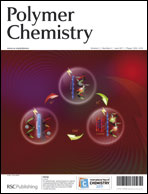Poly[2,2′-(4,4′-(2,6-bis(phenoxy) benzonitrile))-5,5′-bibenzimidazole] (PBI-CN) was synthesized via the polycondensation of 3,3′,4,4′-tetraaminobiphenyl and 2,6-bis(4-carboxyphenoxy) benzonitrile. The introduction of the nitrile group to the main chain of PBI-CN can provide both strong polarity and a reactive site for further reaction. The effects of different reaction conditions on the intrinsic viscosity of the synthesized polymer are discussed, which is consistent with the regular pattern. After appropriate purification of starting materials and optimization of polymerization conditions, the synthesized polymer can exhibit higher intrinsic viscosity, which means higher molecular weight. The solubility, chemical oxidation stability, thermal degradation behavior, acid doping ability, and proton conductivity of the synthesized polymers were studied. Compared with poly[2,2′-(m-phenylene)-5,5′-bibenzimidazole] (PBI-ph), the introduction of –C≡N and –O– group in PBI-CN provides the polymer with better acid doping ability and chemical oxidation stability, while the solubility and thermal stability decrease a little. The proton conductivity of PBI-CN/3.5H3PO4 composite membranes can reach ∼10−3 S cm−1 at 170 °C under anhydrous condition. The temperature dependence of proton conductivity of the acid doped membranes can be modeled by an Arrhenius relation.
![Graphical abstract: Synthesis and properties of poly[2,2′-(4,4′-(2,6-bis(phenoxy) benzonitrile))-5,5′-bibenzimidazole] for proton conducting membranes in fuel cells](/en/Image/Get?imageInfo.ImageType=GA&imageInfo.ImageIdentifier.ManuscriptID=C0PY00242A&imageInfo.ImageIdentifier.Year=2011)

 Please wait while we load your content...
Please wait while we load your content...